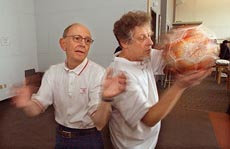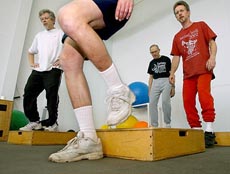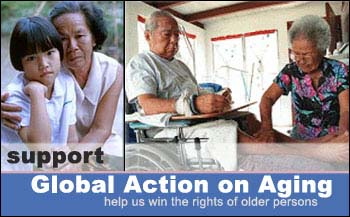

 |
 |
|
|
|
||
| SEARCH | SUBSCRIBE | ||
|
Can exercise ward off
|
 |
| Parkinson's patients Dick Beyer of Bethel Park, left, and Bill Perer of Squirrel Hill pass a soccer ball back and forth as part of one of their regular workouts at the UPMC Center for Sports Medicine on the South Side. |
As Parkinson's patients Dick Beyer and Jim Cordy jog backward through the UPMC Center for Sports Medicine parking lot, tossing a soccer ball to each other, they show no signs of the tremors, stooping and balance loss typical of people with the disease.
The idea of their experimental exercise program is to keep them that way.
They and two other men within the 55-to-70 age range are guinea pigs for a theory under development by neurologists, neurochemists, physical therapists and others at the University of Pittsburgh. The theory is that exercise can either slow or reverse the effects of Parkinson's, long considered an irreversible disease, with loss of movement one of the primary symptoms.
The prospect sounds almost too simple to believe, but studies on rats at Pitt and the University of Texas have given the idea credibility. Researchers here are expecting approval this month of a $5 million National Institutes of Health grant to help them explore it further.
To someone like Beyer, 60, whose subtle Parkinson's impairments include difficulty using a fork, the exercise theory is worth examination. He works out on a Nordic Track in his Bethel Park home regularly, six years after being diagnosed with the disease.
"I think it's plausible ... and hey, exercise is cheap," the recently retired engineer said of the potential value, moments after he and the three others completed an hour of jogging stairs, stretching, playing basketball, kicking soccer balls and other activities sometimes considered too difficult for individuals with Parkinson's.
Members of the group under the direction of physical therapist Kathi Brandfass are still in the mild stage of Parkinson's, which gradually robs the motor skills of about 1 percent of the population over age 55. Individuals can live with the symptoms for years, but the death of nerve cells incapacitates about a third of them within five years of diagnosis.
From January to April, Brandfass said, the abilities of her exercise participants improved drastically. They became able to nimbly take quick steps on and off platforms without tripping, to run up and down two flights of stairs five times instead of once without stopping, and to coordinate multiple physical tasks simultaneously.
 |
| Members of Kathy
Branfass' informal exercise group at UPMC -- all of who are in early
stages of Parkinson's disease -- from left are Bill Perer, Fred Kramer
and Jim Cordy, all of Squirrel Hill. They're doing a stepping drill. |
"I have this sort of Cadillac group here, very motivated," said Brandfass, noting that two of the volunteers are officers of the Pittsburgh chapter of the National Parkinson Foundation.
"For the general geriatric population, you know what's at stake if you don't keep moving. These men have the disease process superimposed upon that, and they have even more at stake. It's very important for them to keep active."
Researchers led by Dr. Michael Zigmond, a Pitt neurochemist and associate director for basic research at the Pittsburgh Institute for Neurodegenerative Diseases, are aiming to determine how much and what kind of exercise can make a difference to someone with Parkinson's, and at what juncture in the disease it's valuable.
For now, the work is focused on animals, because the effects on their brains and key nerve cells can be studied in a way that isn't possible with humans. Brandfass' work with the four men who have the disease is just a small sidelight to the laboratory work until clinical trials are conducted on larger numbers of humans, which may be several years away.
University of Texas researchers led the first study, published in 2001, to show that rats forced to use limbs that mimicked the effects of Parkinson's could regain motor skills within a week of physical activity. Examination of the rats' brains showed that cells that had died in sedentary rats survived in those forced to be active.
The findings echoed those of previous studies in which stroke victims forced to use impaired parts of their bodies could regain functioning better than if they'd been left alone.
 Zigmond, who focused previously on other aspects of Parkinson's, became
enthused by the Texas findings and now heads a group of 20 faculty from
Pitt, Texas and Wake Forest University examining the possibilities in more
detail.
Zigmond, who focused previously on other aspects of Parkinson's, became
enthused by the Texas findings and now heads a group of 20 faculty from
Pitt, Texas and Wake Forest University examining the possibilities in more
detail.
In addition to expanding animal studies over the next several years, the five-year, $5 million project would examine ways to diagnose Parkinson's in humans earlier.
Dr. Robert Moore, a Pitt neurologist involved in that effort, said the tremors and impaired movements that enable diagnosis of Parkinson's typically occur five to seven years after nerve cells begin degenerating.
Whether exercise becomes the best defense against the disease, or whether it's some promising drug therapies that have received attention lately, it's important to speed up the diagnosis, Moore said. Current drugs help manage the symptoms of the disease, but provide no long-term benefit.
The researchers are hoping to develop a battery of tests of reflexes, coordination, balance and more that will identify those likely to have the disease even before symptoms are evident. Confirmation of the disease could then be achieved by a PET scan of the brain.
"The objective is to have treatment such as the exercise programs, which will be neuroprotective, instituted at the earliest possible time," Moore said.
Exercise not only is less costly than medications, it has no side effects, Zigmond said.
"The most conservative guess would be for exercise to slow [Parkinson's] down. I actually think it's not unreasonable to expect it will reverse the disease."
The researchers encourage anyone with Parkinson's or a hint of it to begin exercising, if they're not doing it now. A full-fledged clinical trial won't take place until after more is learned from rats and mice.
"It's not like an experimental medication, so it's certainly not going to hurt anybody to exercise," Zigmond said. "It seems there's no reason to wait."
He has agreement from Fred Kramer, 70, a Squirrel Hill resident participating in Brandfass' informal experiment. Diagnosed 12 years ago, he has sloppy handwriting and some mild signs of the disease, but he hopes to hold off more serious effects.
He visits the Jewish Community Center regularly to use its stair-climbing and Nautilus machines.
"I think it'd be foolish to think it's the magic bullet, but anything that can be even a little helpful is worth doing," Kramer said.
Copyright
© 2002 Global Action on Aging
Terms of Use | Privacy
Policy | Contact Us